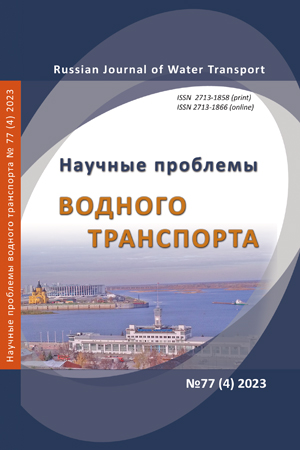Issues of laser welding technology of the ends of heat exchange pipes in pipe gratings.
Abstract
The paper shows that the reliability and service life of shipboard heat exchangers largely depends on the quality of fixing heat exchange pipes in pipe grids. The methods of fixing pipes in a pipe grid depends on many factors: the type of heat exchanger, the material from which the pipes and pipe grids are made, the thickness of pipes and pipe grids, technological capabilities taking into account the chosen design, etc. One of the most effective ways of fixing pipes in the tube grids of heat exchangers is welding. Welds are characterized by strength, manufacturability, and provide a high service life of the joint.
In the article, it is proposed to use laser welding to perform welded joints. Laser welding provides a high focused energy density concentrated on a very small area with relatively low energy input and heating of adjacent metal layers. In laser welding, there is no strong ionizing radiation, the magnetization of the workpieces does not affect the laser beam, which is relevant when welding magnetic materials. The effect of laser radiation is highly local, carried out in the air, including in the environment of protective gases. Thanks to this, laser welding can be used without problems to connect large-sized metal structures.
The laser beam is easily transported with the help of mirror optical systems or through a light guide and is directed to hard-to-reach places. At the same time, reliable and operational control of the laser welding process with adjustable energy characteristics is provided. The article describes the technological equipment that can be used for welding heat exchange pipes and pipe gratings.
References
Хряпченков А.С. Судовые вспомогательные и утилизационные котлы: Уч. Пособие. – 2-е изд. Перераб. и лоп. – Л.: Судостроение, 1988. 296 с.
Усов С.В., Шиганов И.Н., Жданов А.В., Точилин И.П., Митрофанов А.Н. Металлофизические исследования поверхностей при лазерной сварке и лазерной резке / Сварочное производство. 2022. № 10. С. 43-50.
Васильев А.А., Горский А.И., Орешкин А.А., Осинников А.А., Пономаренко Д.В., Шиганов И.Н. Применение азота в качестве защитного газа при лазерной сварке нержавеющей стали / Сварочное производство. 2022. № 1. С. 22-27.
Магдин А.Г., Дюсегалиев Р.М., Припадчев А.Д., Горбунов А.А. Гибридизация лазерной сварки / Транспортное машиностроение. 2022. № 10 (10). С. 12-18.
Поливанов А.Ю., Иванов Ю.В., Холин Д.В. Калибровка видеосенсора системы технического зрения промышленного робота для лазерной сварки / Вестник МГТУ "Станкин". 2019. № 2 (49). С. 119-126.
Саубанов Р.Р., Звездин В.В., Хисамутдинов Р.М., Портнов С.М. Управление процессом лазерной сварки / Социально-экономические и технические системы: исследование, проектирование, оптимизация. 2020. № 2 (85). С. 47-56.
Рахимов Р.Р., Звездин В.В. Прецизионное наведение фокуса лазерного излучения на стык при сварке длинномерных конструкций / Социально-экономические и технические системы: исследование, проектирование, оптимизация. 2021. № 1 (87). С. 74-82.
Новиков В.Г. Анализ и расчет параметров процесса лазерной сварки металлических листов с учетом их физико-технических особенностей / Известия Тульского государственного университета. Технические науки. 2022. № 10. С. 520-522.
www.youtube.com/ Обзор лазерных технологических головок для реализации сварки.
www.raylase.de Гальвано-сканирующие головки.
www.moewe-optics.com Cканирующие головки.
www.scansonic.de Интелектульная лазерная обработка.
www.precitec.com Объективы промышленной лазерной сварки.
www.ipgphotonics.com Объективы с программируемой траекторией осцилляций.
(www.ipgphotonics.com) Лазерные установки программируемой траекторией.
Copyright (c) 2023 Russian Journal of Water Transport

This work is licensed under a Creative Commons Attribution 4.0 International License.













